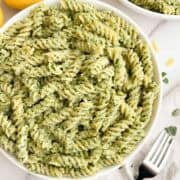Ricotta Pesto Pasta
This ricotta pesto pasta is creamy and fresh! It has a no-cook sauce that is bursting with rich ricotta flavor, fresh basil pesto, and bright lemon zest. Ready in under 30 minutes, it's perfect for busy weeknight dinners or whenever you want an easy and quick meal!
Servings: 8
Calories: 275kcal
Ingredients
- 1½ tablespoons kosher salt (plus more to taste)
- 1 pound fusilli (dried)*
- 1 cup ricotta (whole milk; liquid drained)
- 1 cup pesto *
- 2 teaspoons lemon zest (about 1 lemon)*
- ¼ cup Parmigiano Reggiano (grated; plus more for garnish)*
Instructions
- Cook the pasta: bring a large pot of water to a boil. Add the 1½ tablespoons of salt and stir. Then add the fusilli and cook al dente, according to the package instructions. Just before the pasta is done, reserve 1 cup of the pasta water and set aside. Then drain the pasta when ready.
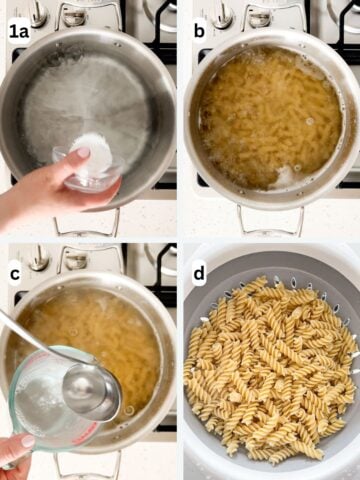
- Make the ricotta pesto sauce: while the pasta is cooking, add the ricotta, pesto, and lemon zest in a large mixing bowl. Stir together until combined.
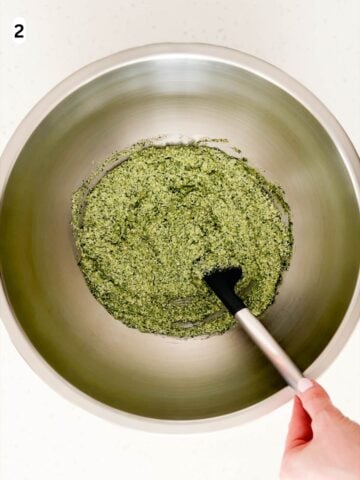
- Combine the pasta and sauce: add the drained pasta to the large bowl with the ricotta pesto sauce. Stir together until the pasta is evenly coated. Add the reserved pasta water gradually as needed to reach a sauce consistency that is creamy and coats the pasta well.
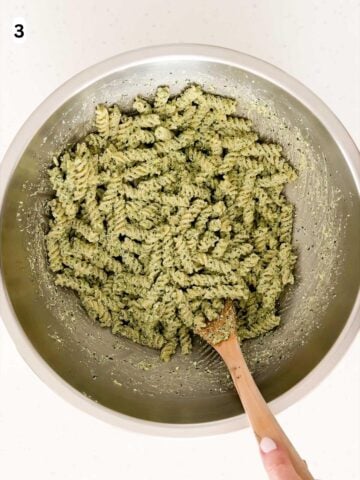
- Add the Parmigiano Reggiano and serve: stir in the Parmigiano Reggiano until it is melted. Add salt to taste and pasta water as needed. Garnish with more Parmigiano Reggiano, serve immediately, and enjoy!
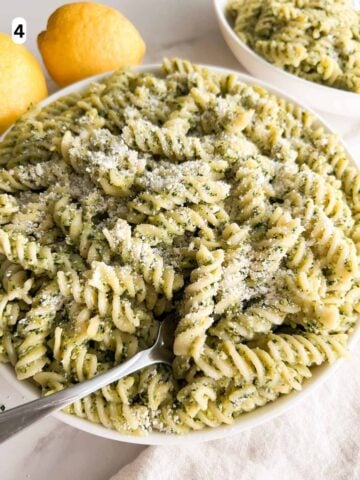
Video
Notes
- Fusilli: you can substitute with a different pasta shape. Ricotta pesto is thick, pairing well with a shorter pasta that captures the sauce. Penne, rotini, farfalle, or orecchiette are great options.
- Pesto: you can use store bought or homemade. I prefer making my own for the best flavor, using this homemade pesto recipe that makes the perfect amount.
- Lemon zest: you can use a zester or box grater (the side with the smallest holes) to scrape off the outer, yellow peel. Avoid the bitter white part underneath.
- Parmigiano Reggiano: I recommend grating your own for the best flavor and even melting. If you don't have Parmigiano Reggiano on hand, you can substitute with another cheese. Pecorino Romano and parmesan are great options.
- Add spice: add crushed red pepper flakes to the ricotta pesto sauce for a hint of spice. Start slow with ¼ teaspoon, adding more to taste as desired.
- Fresh pasta conversion: you can substitute 1½ pounds of fresh pasta for every pound of dried. Adjust the cooking time accordingly because fresh pasta cooks faster. Go slowly when adding pasta water to the sauce at the end. Since fresh pasta absorbs less water, it can get too liquidy if you add too much.
- Storage: the leftovers can be stored in an airtight container in the refrigerator for up to 3 days. I like to save some pasta water too, for freshening up the sauce. I don't recommend freezing because the pasta can become mushy.
- Reheating: leftovers can be reheated in a skillet over medium-low heat. Add a bit of pasta water to the skillet to loosen the sauce and prevent it from drying out. You can also use a microwave in 30 second increments. Leftovers should be reheated to 165°F (74°C) throughout.
Nutrition
Serving: 1cup | Calories: 275kcal | Carbohydrates: 45g | Protein: 13g | Fat: 19g | Saturated Fat: 5g | Trans Fat: 0g | Cholesterol: 18mg | Sodium: 1074mg | Potassium: 225mg | Fiber: 2g | Sugar: 2g | Vitamin C: 0mg | Calcium: 161mg | Iron: 1mg
